If you’ve read what we have, you’ll be convinced that if you’re serious about boondocking, an RV inverter charger is an essential bit of kit.
Well we’ve been living in our camper full time since 2018 and we don’t have an RV inverter charger so they’re not what we’d call essential.
Living in a van comfortably full-time, at least for us, demands a certain level of available electric.
We want to keep a fridge on and maintain good ventilation by running the roof vent. Our campervan heater and diesel cooker both need a power supply.
Even our composting toilet needs a small but constant electrical supply.
All these appliances run directly from the battery bank.
A well sized camper solar setup will help meet much, if not all, your off grid demand, keeping the batteries in tip top condition.
But what about AC appliances like laptops, camera batteries, air conditioning units and microwaves?
And what about charging the batteries when the weather is off, so not enough solar to meet the demand?
This is where inverters, converters or a combined RV inverter charger step in.
This post is one part of a mini series about RV converters and inverters.
Here we focus specifically on combined RV inverter charger units.
The post explains what they are, how they work and importantly the pros and cons of these over choosing a separate inverter and converter.
You’ll be able to figure out what size you need and the key features to look out for when buying.
We’ve recommended our top picks of RV inverter chargers too.
So are you ready? Here’s everything you need to know about RV inverter chargers.
When you click on links to various merchants on this site and make a purchase, this can result in this site earning a commission. As Amazon Associates, we earn from qualifying purchases. For more info, please check our disclosure page.
The Best RV Inverter Chargers | Our Top 3 Picks
The models of inverter chargers we’ve included here are some of the most popular sizes.
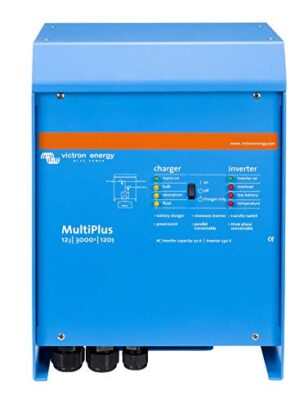
- 3000w pure sine wave inverter with 6000w surge
- 100A smart battery charger
- Lithium, AGM & Gel battery compatible
AIMS 3000 Watt Inverter Charger
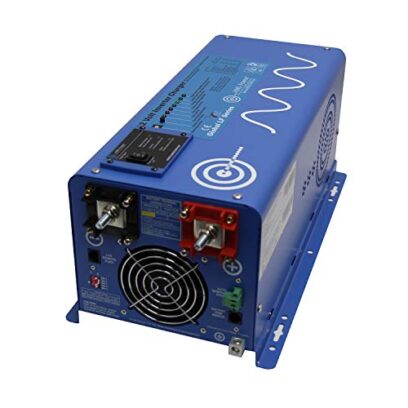
- 3000w pure sine wave inverter with 9000w surge
- 100A smart battery charger
- Lithium, AGM & Gel battery compatible
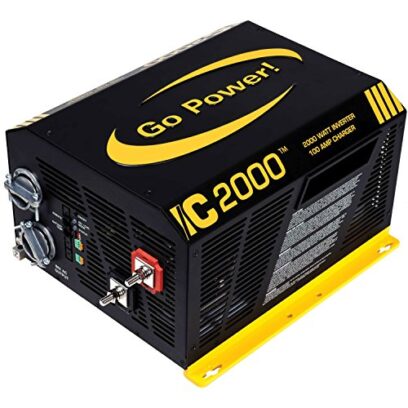
- 3000w pure sine wave inverter with 3400w surge
- 125A smart battery charger
- Lithium, AGM & Gel battery compatible
What does a Power Inverter Charger do in an RV?
In the most simple terms, a power inverter charger does the job of both an inverter and a converter.
We’re written detailed posts on both RV inverters and RV converters but to summarise the key points:
An inverter’s job is to change DC power to AC power.
12v camper leisure batteries store DC power but household appliances normally plugged into a power outlet need an AC power source.
So appliances like microwaves, laptop chargers, coffee makers or TVs, won’t run directly from the battery bank.
Instead, stored DC power must be converted to AC first.
The converter’s job is to change AC power to DC power.
Camper’s leisure battery banks can only be recharged with DC power.
To take advantage of a mains shore power on a campsite or at home to top up the batteries, the mains supply must be converted.
The voltage must be stepped down and transformed from 110v or 240v AC to 12v DC first.
Some RVs already have a converter and/or inverter installed. But if your camper isn’t one of them, you want to replace them or you are building a camper conversion, you can buy a combined power inverter charger.
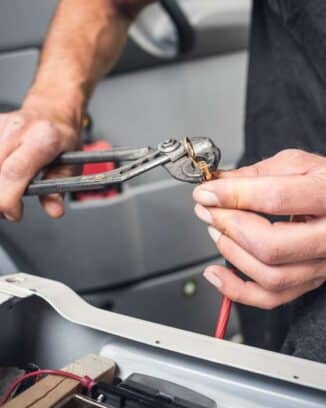
Need help & advice with your electrical setup?
Join Our Facebook Support Group
Why do I Need an Inverter Charger in my RV?
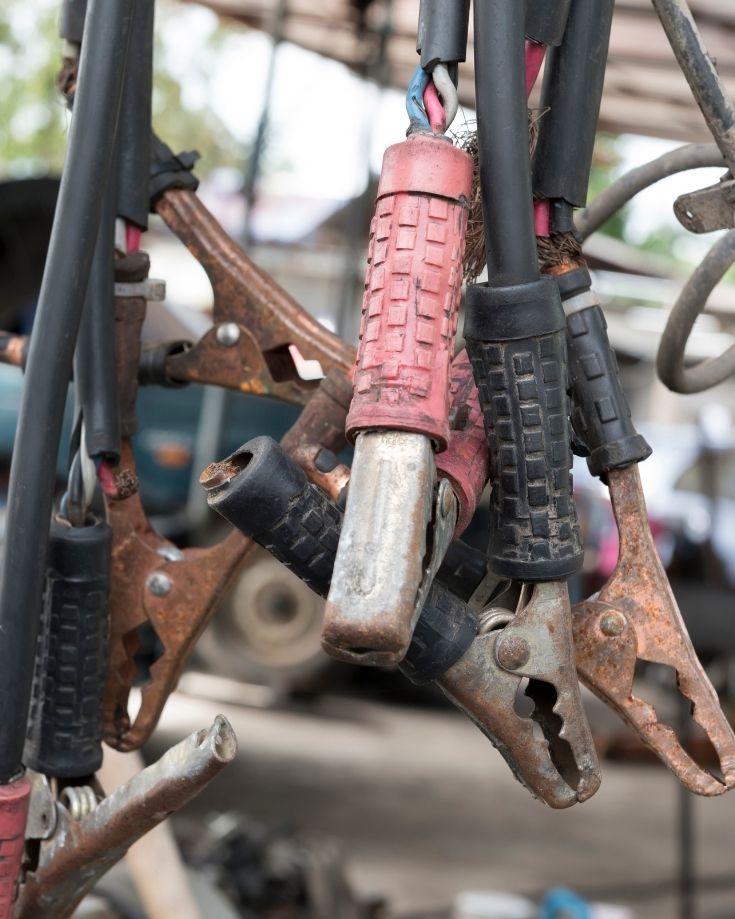
The short answer is you don’t need a combined inverter charger in an RV or campervan.
If your camper doesn’t have a battery bank, all your household AC appliances will run on the mains circuit when hooked up to a mains supply.
By making sure all devices, lights and appliances use AC, there’s no need to convert that power to DC.
Inverter chargers aren’t cheap components so it’ll save you money and unnecessary complexity in your electrical design too.
Even if you do have a battery bank installed, a combined inverter charger still isn’t absolutely essential.
With enough solar capacity, you may never need to charge the batteries from a mains supply so may not need the converter element.
We managed to live through a Patagonian winter with no driving or hookup (global travel restrictions at play), and we coped just fine.
If you have no AC appliances onboard that you’ll use off grid, then you don’t need the inverter element.
So the long and the short of it is, if you need to convert AC to DC AND DC to AC, you might need a power inverter charger.
We’ll cover this off more in the advantages and disadvantages section below
How Does an Inverter Charger Work?
AC power oscillates, changing direction between positive and negative voltages.
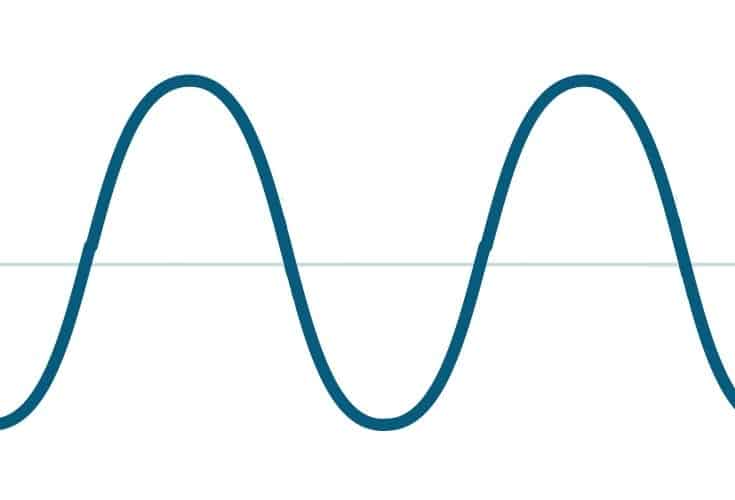
DC power travels in one direction, seemingly a straight line.
An inverter charger converts AC to DC (the converter bit) and DC to AC (the inverter bit).
The inverter consists of a series of switches, diodes or transformers. As the DC current enters the inverter, these diodes open and close in rapid fire, either 50 or 60 times a second, depending on what frequency the supply provides.
This turns the straight line, single direction DC voltage into the characteristic wave of AC, amplifying its voltage value from 12v to either 110v or 240v, as per the manufacturers’s specification.
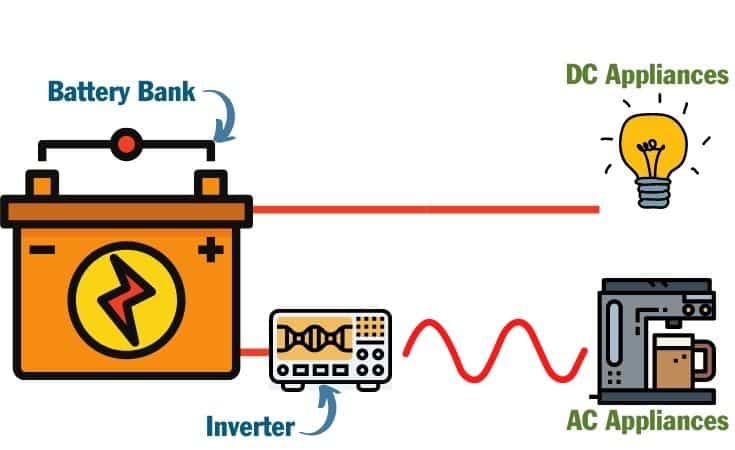
The converter consists of a series of capacitors. These act as mini electron stores catching the AC power as it enters the converter. Synchronised, they create a solid, flat line DC output.
The converter then transforms this to the correct voltage, usually 12v for campervans, RVs and motorhome battery banks.
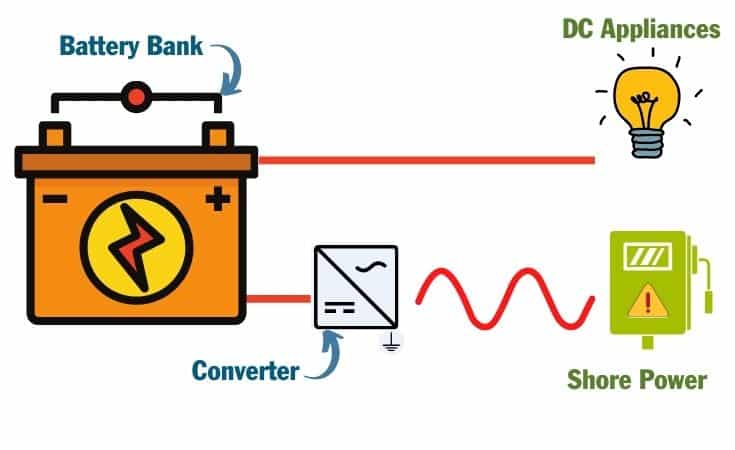
Different Types of Inverters & Converters
There are different types of inverters and converters. Most manufacturers combine the best type of each into their combined inverter charger models.
The converter element is usually a multi-stage charger, sometimes called a smart charger or smart converter.
It constantly responds to the state of the battery, delivering the optimum amount of current to charge it as fast and as safely as possible.
There’s usually at least 4 stages:
- Bulk | The converter delivers as much current as the battery will accept until about 80% charged
- Absorption or cool down cycle | The converter lowers the input current and gradually brings the battery upto almost full charged
- Float or trickle charge or maintenance charge | The converter trickles current into the battery, maintaining it at full charge
- Equalize | Especially important for lithium batteries, this stage improves the overall battery capacity
Some chargers have even more stages than this and can include diagnostic checks, restoring completely dead batteries and more.
The inverter part is usually a pure sine wave, which most closely matches the power from a mains supply.
The voltages it produces increase and decrease in a smooth transition from positive to negative.
The waveform is smooth, giving a clean consistent supply of energy so you can run all your electrical appliances and electronic gadgets.
What Size Inverter Charger Do I Need in my RV?
Before choosing an RV inverter charger, it’s prudent to work out what size inverter and converter you need separately so you buy a model to meet both needs.
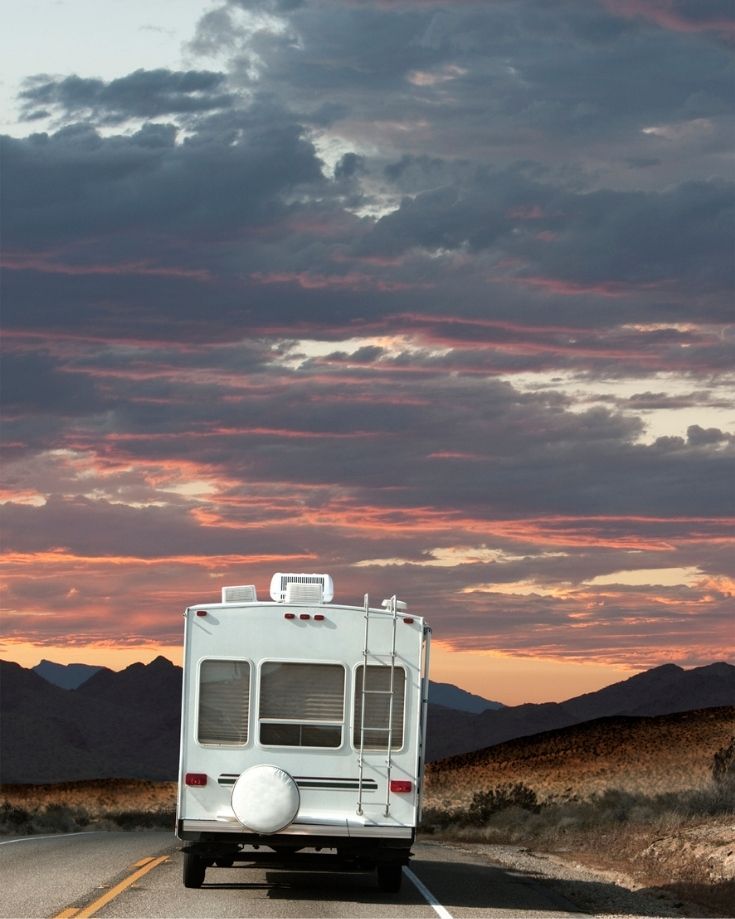
Sizing the Inverter
Power inverters are sized in watts.
It needs to be powerful enough to run the AC components connected to it at any given time.
We recommend a rating of about 25% higher than the most power hungry appliance you intend to put on the system.
So let’s say you have a 240w slow cooker, a 200w blender and a 300w TV.
The camper’s electrical system needs a much larger inverter to run them all at the same time than if you limit yourself to only using one at a time.
To help you figure out what size you need, we’re created an inverter calculator. It will also help you assess what size solar system you need to power it too.
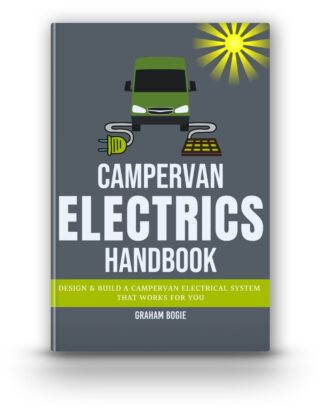
Everything you need to know about campervan electrics. Now available in ebook and paperback!
Learn how to design, size, install and troubleshoot your camper’s electrical system.
Sizing the Converter
Converters are sized in amps.
It needs to be powerful enough to provide the total current you’ll draw down at any one time.
A battery bank will draw a maximum current based on the manufacturer’s specification. Look for the Maximum Charge Current on the spec.
As an example, let’s say you have a 200ah battery bank made up of 2 x 100ah Gel batteries and they’re half full. They each have a maximum charge current of 30 amps.
This means if you provide 30 amps each (so a 60 amp converter), they’ll take it.
A 60 amp converter will take less than 2 hours to fully recharge them, longer if you also have load on the batteries as they charge.
Going up a size gives some wiggle room for additional DC demand, though the batteries will still only take 30 amps each at most so won’t charge any faster.
You can go with a smaller one and accept the batteries will take longer to charge.
If you do go smaller, make sure the minimum size is at least 10% of the total battery bank size. So if you have a 200ah battery bank, make sure your converter is at least 20 amps.
What to Look for When Buying an Inverter Charger
There’s a lot of inverter chargers available on the market.
Even once you’ve calculated the size needed, there’s other aspects of the component’s specification and features important to look at before making your final decision.
We have most of this covered off in our posts specific to inverters and converters but for completeness, we’ve included it here too.
Input Voltage Range

This indicates the voltage of the mains supply needed to supply the inverter charger.
In the US, this is probably 110-130v while in Europe and the UK is more likely to be 220-240v.
If you’re a global traveller, choose an input voltage to match the location you plan to spend most of your time.
We use a transformer with our 240v battery charger when we hookup to a 110v supply.
Output Voltage
This indicates the voltage the battery charger will supply the battery.
Most RV and campervan electrical systems have a 12v battery bank. Some have 24v and even fewer have 48v.
Buy an inverter charger with an output voltage to match your battery bank voltage.
Efficiency Rating
This is the overall efficiency of the inverter charger. An inverter with a 90% efficiency rating uses 10% more energy than the device its supplying.
The greater the efficiency rating the less heat the component generates when in use and the less current losses experienced.
A higher efficiency rating means it will draw less current from the hook up point.
Some campgrounds limit the current a camper can draw from their electrical system hook up points and this is especially important then.
Let’s say the campground has a 25 amp limit on its AC hookup point. This needs to supply your RV inverter charger and all AC appliances on your mains circuit.
If a power inverter charger is taking 7 amps, this leaves 18 amps for your microwave, TV, air conditioning and so on.
Take more than this and the circuit breakers will trip and you’ll lose all power.
If the hook up connection point is locked (common practice in Europe) you’ll need to get the campsite staff to open up and reset the trip switch.
A less efficient inverter charger may take 8 or even 9 amps, so reducing the amount of AC available before it trips.
Some inverter chargers, like the Victron, feature a control panel.
This allows you to set a limit on the draw from the hookup. Any connected appliances are prioritised with remaining current used to charge the battery. This prevents any tripping.
Maximum Charge Current
This indicates the maximum amps the unit can output.
It’s what you size the converter based on your batteries and load as described above. This needs to be big enough to accommodate your needs.
Charge Algorithm
Multi stage battery chargers (the converter part of the component) can have upwards of 3 stages controlling adaptive battery management.
The charge algorithm indicates how many stages are in that battery management system.
Battery Compatibility
Most, if not all inverter chargers are compatible with lithium batteries, AGMs and Gel but double check before buying.
Transfer Switch
Some inverter chargers have this nifty feature.
They sense if the mains supply has failed and automatically flip to either another AC supply (like an auto start RV generator) or to the DC battery bank.
Continuous Power (sometimes called running power)
This refers to the inverter function of the component.
A 1000w inverter charger can provide continuous power of 1000w meaning it can supply this amount of power for as long as there’s a sufficient DC supply.
Peak or Surge Power Rating
Also pertaining to the inverter function, the component can provide a greater surge of power in short bursts. This is especially useful for appliances that demand a power surge on start up, like a compressor fridge.
They take a large power surge to get going, before quickly dropping back to their running level.
Inverter chargers often have a peak rating greater than the continuous power rating.
Check your appliance specifications for any surge demand.
Safety Features
Inverter chargers come with safety protection features, offering greater reassurance and protecting the van electrics.
They vary from device to device but here’s a list of common features:
- Auto cut off, LED indicators and alarms for under and over-voltage protection, over-temperature protection, over-load protection, and short circuit indication.
- High-speed ventilation fans to help keep the inverter running at a low temperature
- Ground-fault circuit interrupter (GFCI) protection
- Remote monitoring
Should I Install a Power Inverter/Charger in my RV?
We may all want the top of the range components installed in our campers and these inverter chargers are certainly marketed as just that.
They have all the bells and whistles for sure and arguably replacing 2 components for 1 has got to be a good thing.
Right? Well not necessarily.
If planning your campervan electrics from scratch, you may be tempted to go with the combined unit rather than separate inverter and converter.
But hold fire and weigh up the pros and cons first.
Pros
- One unit can replace 2 or even 3 other components (inverter, converter and transfer switch)
- A single unit is easier, quicker and less complex to install than 2 or 3 components
- Less wiring and a more neat finish
- The in-built transfer switch is most convenient for those of you connected to auto start generators or prefer not to switch to the batteries manually
- Power inverter chargers were designed primarily for industrial use so you can count on them being robust and versatile
Cons
- The single unit is quite large so finding a suitable location in limited space may not be as easy as fitting 2 smaller component
- If any component within the unit fails, you might be left without both inverter and converter until you replace or fix it
- There’s a lot of features on many of the inverter chargers, some of which may not be necessary. You’ll pay for them anyway
- Sizing the 2 functions isn’t as flexible as if you buy 2 separate components and could be more costly. For example, if you want a 30a converter and a 300w inverter, you’ll need to buy an 800w & 35a inverter charger – much bigger and more expensive than needed
Best Inverter Charger Brands
There are many brands out there that manufacture inverter chargers for RV campers.
If you’re put off by the prices, you only have to check out Amazon for some much cheaper product, most likely imported from China or Russia.
We can’t vouch for these and unlike some of the cheaper diesel heaters from these corners of the world, would recommend steering well clear.
At least until they have a big following and support group.
Well known brands commonly installed in RV campers include:
RV Inverter Charger Wiring Diagram
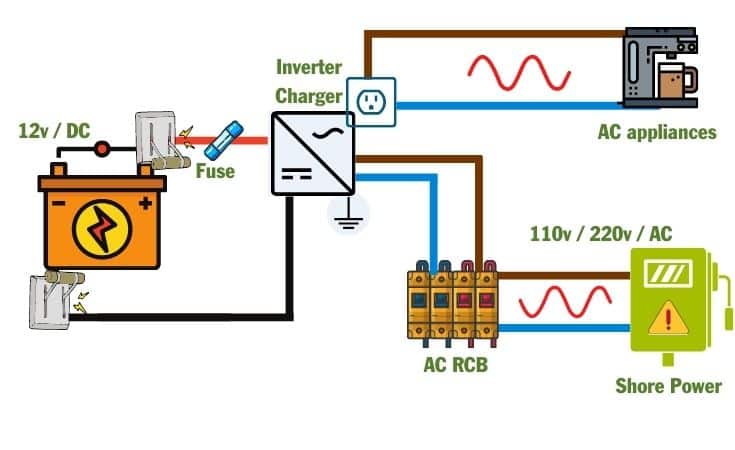
Automatically Create Your Bespoke RV Wiring Diagram
Includes 110v & 240v, solar, B2B, batteries, inverters, 12v, 24v & 48v systems, wire gauges in AWG & mm² & much more!

Graham Bogie

Graham is a seasoned marine electrical engineer with two decades of experience designing customized electrical systems for plant machinery and converting campers and overland vehicles. His expertise has led him to author the reputable Campervan Electrics Handbook and become the chief designer of the RV Wiring Design Tool. As a knowledgeable figure in the field, his YouTube channel, blog, Facebook group, and newsletter, offering electrical advice and product reviews, reach more than a million users each year.


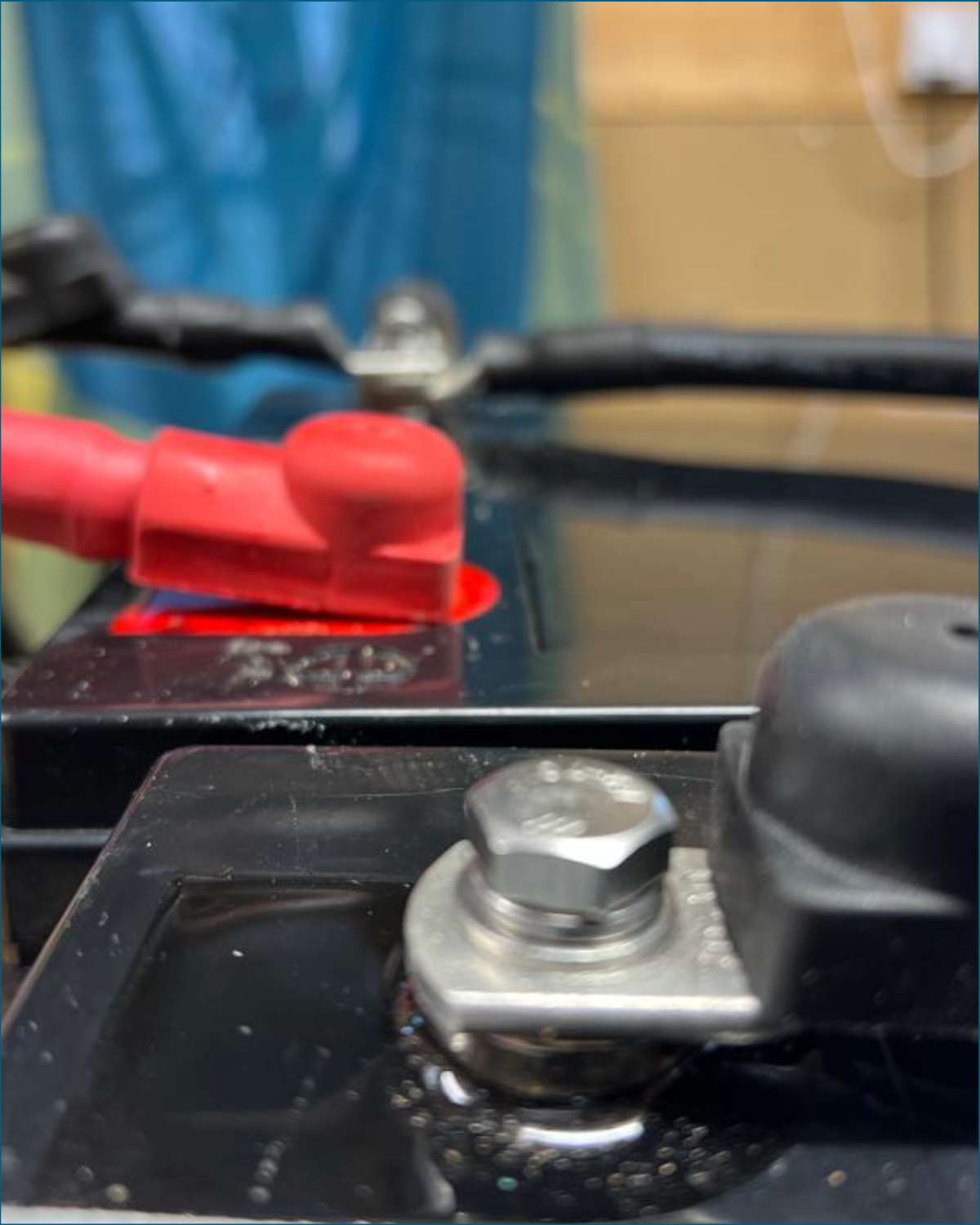

I have the Aims 2000w pure sine wave. Can I connect my DC circuit directly to the battery bank?
Hi Robert. Your DC appliances don’t need any voltage conversion so can run from the battery without going through the inverter charger first. I think this is what you’re referring to so if this doesn’t clarify, let me know. Graham